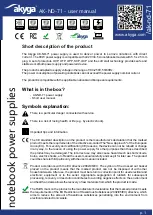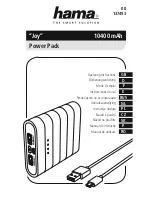
71
21.3. Battery settings
When the battery is detected, entering the menu as usual (via
“
SHIFT
”+”
MENU
”
), will bring you
directly to the menu for various battery charging settings. That menu is also identifiable by the battery
symbol being highlighted, with a red background, in the bottom left of the screen:
.
See chapter
14. Description of Each Setting’s Options
for a description of the various battery menu
entries. That menu is mainly focused on when to
stop
charging.
Outside of that menu, but nevertheless crucial for battery charging, you must set a V-SET and I-SET
suitable for your battery. These 2 settings will act as upper limits
during
charging.
See below, under
for a somewhat more in depth explanation on how to use
all of these settings, depending on your battery’s characteristics.
21.4. Charging Strategies
The chapters below mention some charging strategies, a small explanation of what types of batteries
these can be used for, and most importantly, how to configure that in the RD60xx.
21.4.1. Time limit
The simplest method of charging a battery is time limited charge. Provided a relatively low
current is used, and the charge time is not too long, most batteries can be charged this way. The
downsides are that this method is very unlikely to provide an optimum charge, and when used
inappropriately, can severely shorten the battery life or be downright dangerous.
If you use this method exclusively, be prepared to shorten the charge time as the battery ages,
or you will end up accelerating the ageing even more.
Every type of battery has its own recommendations on how to set the charge current with this
method, but in general, charging an empty battery at 0.1C for 10 hours can be relatively safe. If
your battery was not empty at the start of charge, you must of course adapt the time.
The RD60xx allows you to set a maximum charge time, via
21.4.2. Capacity limit
Another simple method is the capacity limit. This method works by calculating the time integral
of the charging current over the length of the charge process. For example, you charge a
battery with 0.5A for 2 hours, you will have put 1Ah “back into” the battery. As the charge current
often changes (lowers) during a charge cycle, this method will help you better tune the charging
than the simple time limit method. It will however still not prevent overcharging, if you set the
limit too high.







































